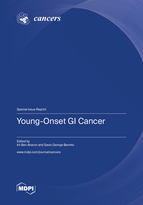Young-Onset GI Cancer
A special issue of Cancers (ISSN 2072-6694). This special issue belongs to the section "Pediatric Oncology".
Deadline for manuscript submissions: closed (20 September 2022) | Viewed by 21847
Special Issue Editors
2. Rapport Faculty of Medicine, Technion, Haifa 3200000, Israel
Interests: young-onset GI cancers; treatment-related toxicity; oncofertility
Interests: public health; acute pancreatitis; pancreatic cancer; young-onset carcinogenesis
Special Issues, Collections and Topics in MDPI journals
Special Issue Information
Dear Colleagues,
In the last decade, the incidence of cancer in young patients had been risen in several cancer types upon the US Surveillance, Epidemiology and End Result (SEER) data and other worldwide registries. Recently, Sung and colleagues had published in Lancet Public Health an extensive pooled analysis from the US that revealed a dramatic increase in cancer incidence among younger adults (aged 25–49 years), mainly in “obesity-related” cancers, most of which are in the gastrointestinal (GI) tract. Several studies over the past decade have indicated a significant increase in colorectal cancer incidence among young adults below the age of 50 years. Current evidence suggest that the majority of early-onset GI cancers are sporadic and harbor no familial etiology, indicating a potential significant role for environmental and behavioral factors in the pathogenesis. Furthermore, the gut microbiome has been proposed to play a key role in CRC carcinogenesis. Efforts are ongoing to advance our understanding of the molecular landscape of these early-onset entities, with the aim of impacting how prevention, screening, and treatment strategies are designed in the future to optimize outcomes for this novel patient population. Young cancer patients often face unique challenges, including treatment-related infertility, late morbidity as cardiovascular diseases as well as psychosocial unique unmet needs, that may exhibit a differential pattern of symptom burden and symptom severity, compared with other young cancer patients of non-GI malignancies which are more commonly characterized in the literature as breast cancer and lymphoma.
The scope of the special Issue of Cancers, is to highlight perspectives of biology, etiology, late-term toxicities and quality of life aspects which are unique and relevant to young onset GI cancers.
Dr. Irit Ben Aharon
Dr. Savio George Barreto
Guest Editors
Manuscript Submission Information
Manuscripts should be submitted online at www.mdpi.com by registering and logging in to this website. Once you are registered, click here to go to the submission form. Manuscripts can be submitted until the deadline. All submissions that pass pre-check are peer-reviewed. Accepted papers will be published continuously in the journal (as soon as accepted) and will be listed together on the special issue website. Research articles, review articles as well as short communications are invited. For planned papers, a title and short abstract (about 100 words) can be sent to the Editorial Office for announcement on this website.
Submitted manuscripts should not have been published previously, nor be under consideration for publication elsewhere (except conference proceedings papers). All manuscripts are thoroughly refereed through a single-blind peer-review process. A guide for authors and other relevant information for submission of manuscripts is available on the Instructions for Authors page. Cancers is an international peer-reviewed open access semimonthly journal published by MDPI.
Please visit the Instructions for Authors page before submitting a manuscript. The Article Processing Charge (APC) for publication in this open access journal is 2900 CHF (Swiss Francs). Submitted papers should be well formatted and use good English. Authors may use MDPI's English editing service prior to publication or during author revisions.








